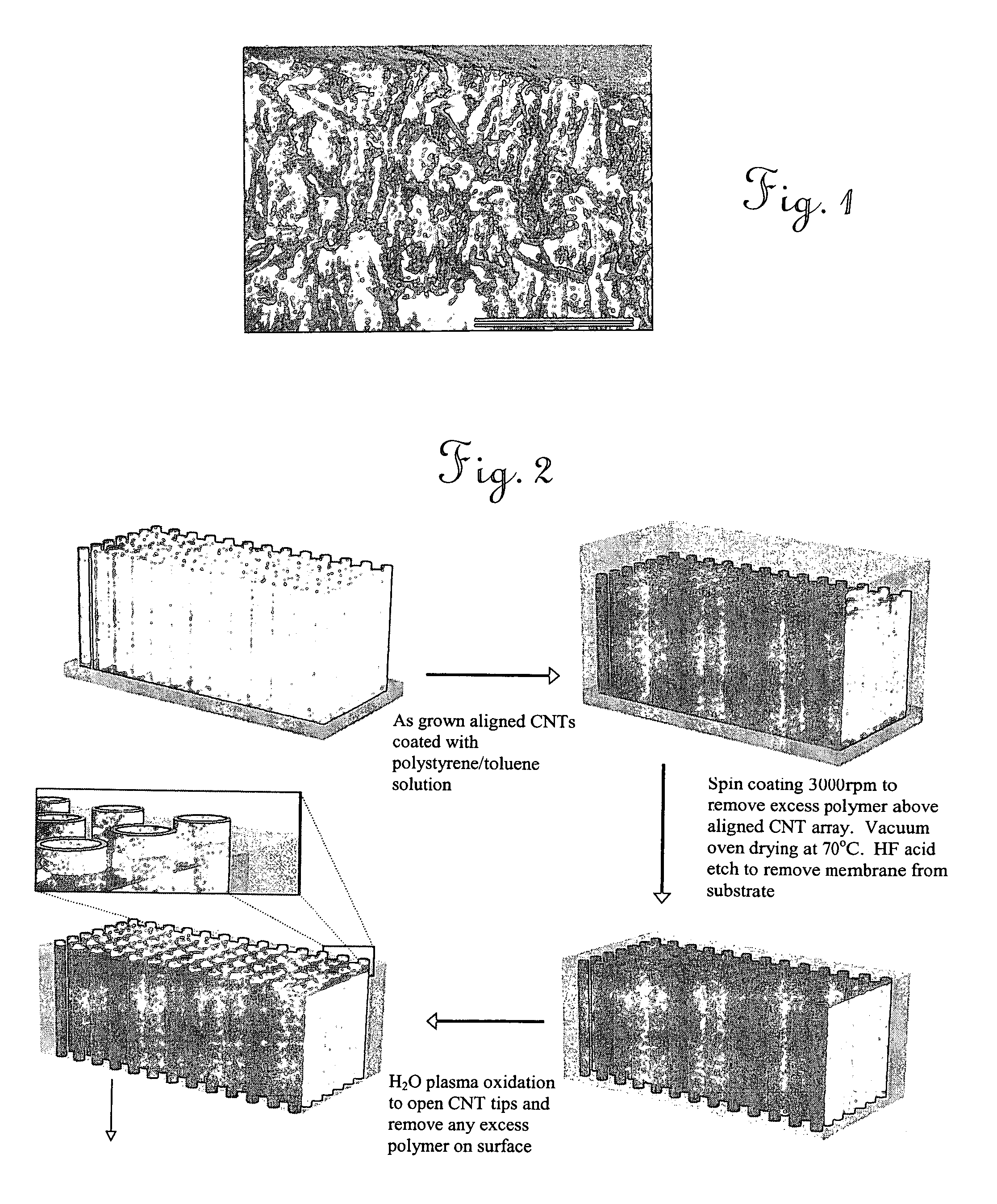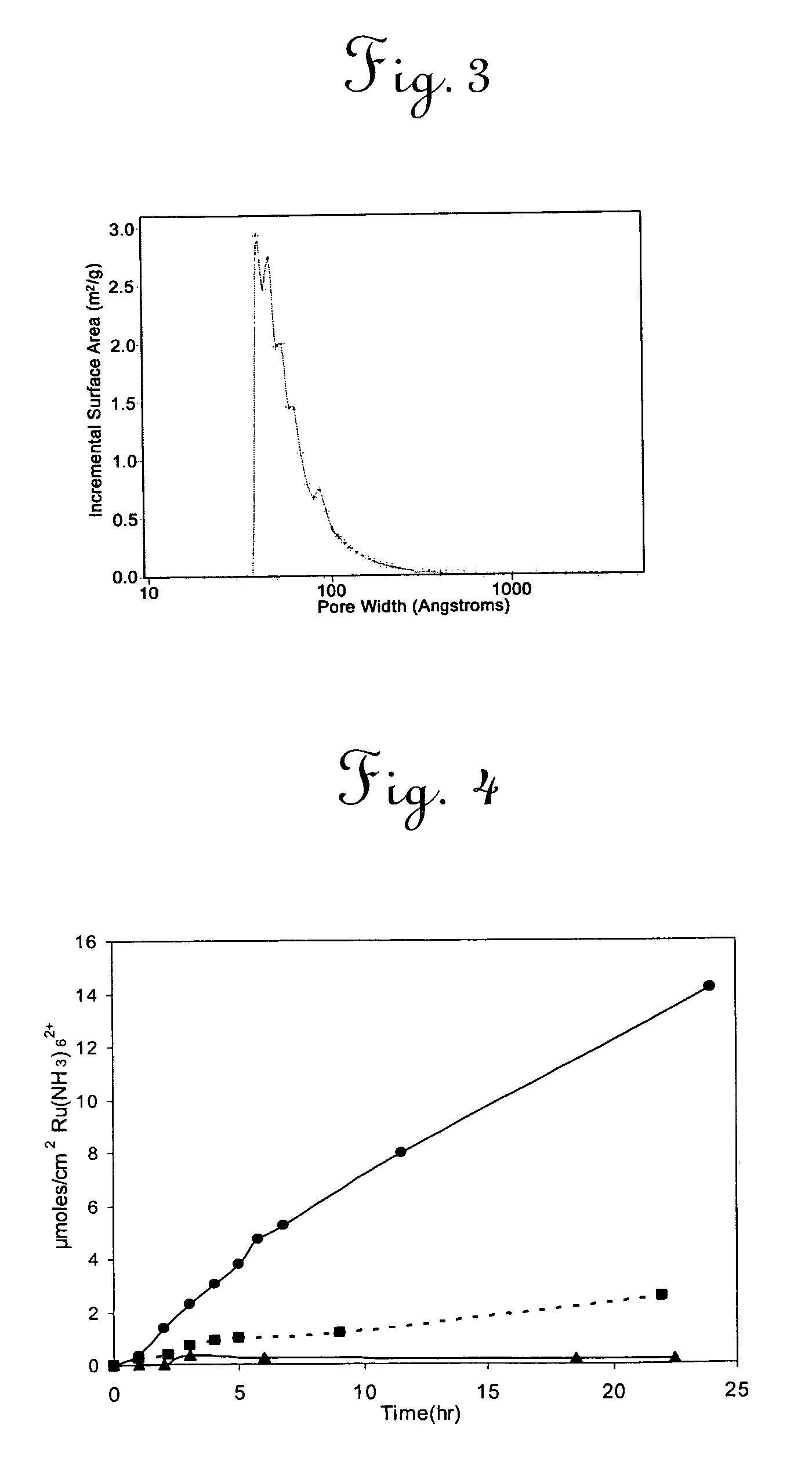Aligned nanotubule membranes
a nanotubule and nanoporous membrane technology, applied in the field of nanoporous membranes, can solve the problems of high surface area inorganic membranes, high surface area, and high cost of nanometer pore sizes, and achieve the effect of enhancing reaction rate and improving decomposition kinetic results
- Summary
- Abstract
- Description
- Claims
- Application Information
AI Technical Summary
Benefits of technology
Problems solved by technology
Method used
Image
Examples
example 1
[0040]An aligned carbon nanotube (CNT) membrane was prepared. Aligned CNT's were grown in situ using substantially the methods described in R. Andrews et al., Chem. Phys. Lett. 303, 467 (1999) (incorporated herein by reference). Briefly, CNT's were grown for 30 min. (with an aligned CNT film thickness of 5 to 10 μm) on quartz substrate, in a chemical vapor deposition process that used a ferrocene-xylene-argon-hydrogen feed at 700° C. A 50 weight-percent solution of polystyrene (PS) and toluene was spin-coated over the surface. PS is known to have high wettability with CNTs, and the CNT array was readily impregnated with PS. Because of the high viscous drag within the CNT array, only excess polymer on top of the composite structure was removed during the spin-coating process. The film was dried in vacuum at 70° C. for 4 days. Hydrofluoric acid was then used to remove the CNT-PS composite from the quartz substrate, to produce a freestanding composite film of 5- to 10 μm thickness. FIG...
example 2
[0047]Example 1 showed that the open tips of the membrane-bound CNT's were readily functionalizable with carboxylate end groups, which could form the basis for gatekeeper-controlled chemical separations or an ion-channel mimetic sensor. If a selective additional functional unit were placed at the entrance of the CNT and coordinated with a bulky receptor, the CNT pore would be blocked and the ionic flow through the CNT core would be reduced. Ionic flow could be easily detected electrochemically and could provide the basis of a selective sensor system.
[0048]Accordingly, the well established biotin / streptavidin analyte / receptor system was chosen. A CNT membrane having carboxylate end groups at the CNT pore tips was prepared substantially as described in Example 1. (+)-Biotinyl-3,6 dioxaoctanediamine (Pierce Biotechnology EZ Link) was reacted with the carboxylate end groups of the CNT membrane with a carbodiimide-mediated reaction. This was subsequently coordinated with streptavidin. FI...
example 3
[0049]It was considered that electrochemistry could also be used to tailor the aligned CNT membrane structure. Practical considerations of membrane strength and aligned CNT growth require that the membrane be at least 5 μm thick. However, for large molecular separations based on gate-keeper selectivity, a short path length is desired, because it increases the diffusion flux.
[0050]The CNT length is trimmed by anodically oxidizing the CNT's at ±1.7 V versus an Ag—AgCl reference electrode. Because the PS polymer is an insulator, the conductive CNT's are selectively etched within a polymer matrix. Thus, one can adjust pore length while maintaining the mechanical integrity of the thicker PS matrix. After H2O plasma oxidation, the tips of the CNT's are extending above the surface because the faster etching rate of PS by plasma treatment. FIG. 5a shows a schematic cross section illustration of CNT's selectively oxidized electrochemically inside an insulating PS matrix. FIG. 5b shows the su...
PUM
| Property | Measurement | Unit |
|---|---|---|
| length | aaaaa | aaaaa |
| thickness | aaaaa | aaaaa |
| thickness | aaaaa | aaaaa |
Abstract
Description
Claims
Application Information
 Login to View More
Login to View More - R&D
- Intellectual Property
- Life Sciences
- Materials
- Tech Scout
- Unparalleled Data Quality
- Higher Quality Content
- 60% Fewer Hallucinations
Browse by: Latest US Patents, China's latest patents, Technical Efficacy Thesaurus, Application Domain, Technology Topic, Popular Technical Reports.
© 2025 PatSnap. All rights reserved.Legal|Privacy policy|Modern Slavery Act Transparency Statement|Sitemap|About US| Contact US: help@patsnap.com



